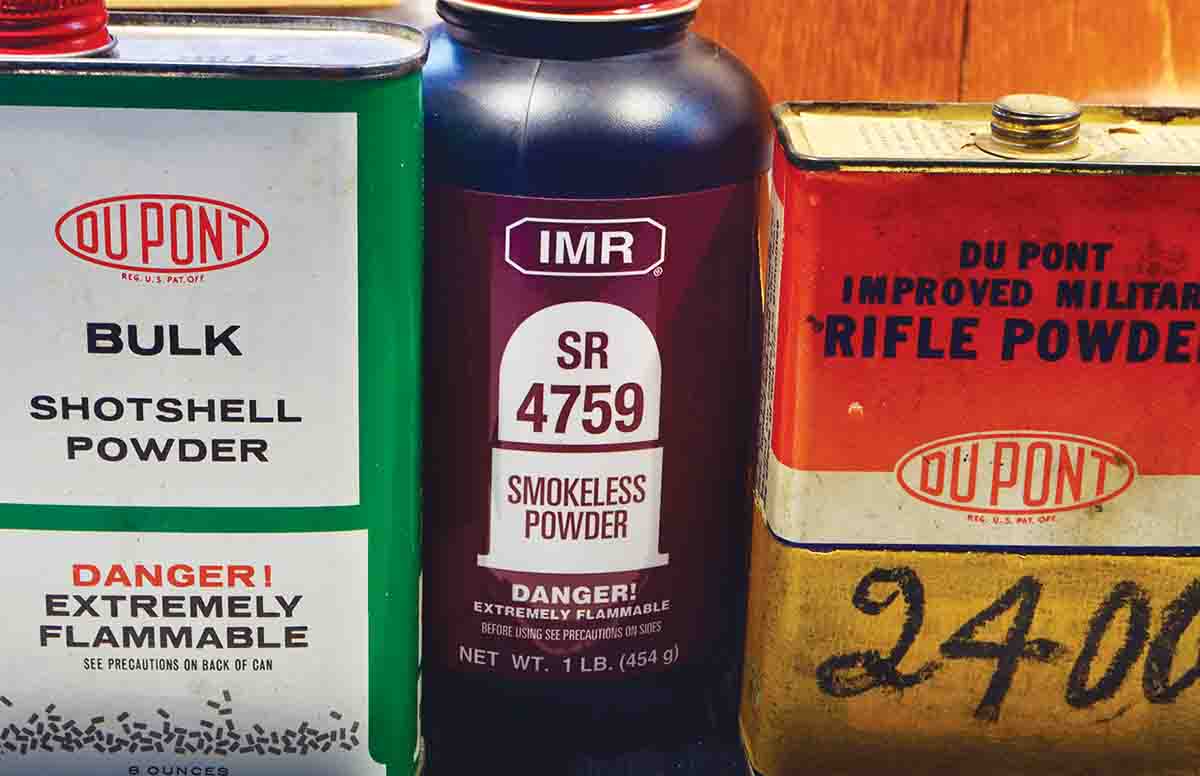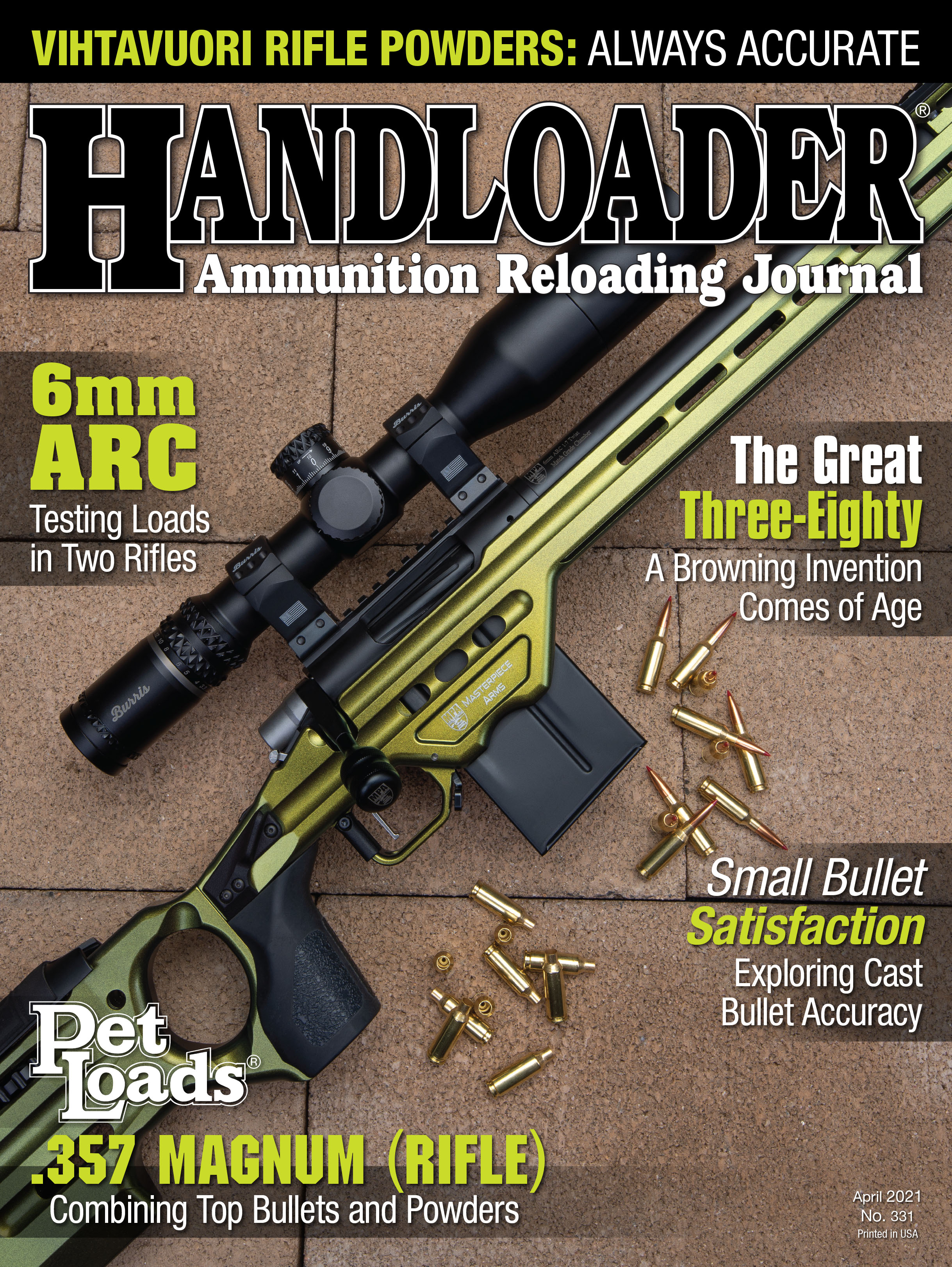In Range
Days of Powders Past
column By: Terry Wieland | April, 21

One of the favorite smokeless powders for this purpose was DuPont Bulk Shotshell, a powder that was loaded “bulk for bulk” with black powder, rather than measured in grain weight. There were several such powders available in the transitional period between black and smokeless, but Bulk Shotshell survived the longest.
A reader wrote to offer me three unopened canisters of Bulk Shotshell, which he had in his stash but had no use for. At the same time, he asked why we don’t publish loading data for such powders. They may be discontinued, but that doesn’t mean handloaders don’t have some sitting around, or a few canisters might be discovered at the back of dealers’ shelves.
The basic reason for this policy is that we want to publish data any reader can use if he has a mind to. If a powder is long discontinued, not everyone has or can find some. The data becomes (shall we say?) less than useful. Conversely, on occasion I’ve had readers complain about giving them information they might like to use, but can’t. Altogether, unless there is a sound historical reason for doing so, it’s easier to just stay away from publishing data about loads that cannot be duplicated.
Many of the articles I’ve written for Handloader over the past decade have dealt with obsolete cartridges chambered in old rifles. Almost always, the purpose has been to show how to get them shooting once again, by fashioning suitable brass or adapting them to the use of readily available powders.
A related problem – and one we are seeing more often now – concerns the renaming or reinventing of old powders, and describing them as “new and improved.” Renaming has become fairly frequent with foreign powders, where the importer changes and the new company wants a distinctive identity. For example, the old Accurate Arms powders usually had AA prefixing the number, such as AA-5744. At one point, the AA was dropped, the powder was listed simply as 5744, and questions were asked as to whether it was the same powder or slightly different – like the difference between IMR-4350 and H-4350. (In its case, 5744 is simply that, regardless of what comes before or after.)
Another wrinkle arises when we try to publish data obtained using a stock of something like AA No. 2, which is what I have on my shelf, but which is no longer sold under that name, even though the “new” Accurate No. 2 is the same powder. Does this mean we’re publishing data with old powder, a still available powder under a new name or a distinctly different powder? In this case, the name has changed but the powder (and corresponding data) has not.
Never before in history have American handloaders had such a variety of powders available from Hodgdon, IMR, Winchester, Alliant, Norma, Vihtavuori, Shooters World and several others. The line of Western Powders, which includes the Accurate numbers, has been sold to Hodgdon and presumably will be incorporated into its offerings wholesale, but operated as an independent line, like IMR.
The downside of this is that decisions of corporate rationalization can result in powders being discontinued for reasons unrelated to their usefulness. IMR’s wonderful old SR-4759, which dates back almost a century, has been discontinued twice – the second time, presumably, for good. It went the first time in the 1960s, because it was deemed to be outdated, was brought back some years later because new uses were found for it, and then discontinued again when these roles were going to be filled by IMR’s Trail Boss.
There are two uses for which SR-4759 is supremely suited: One is as a smokeless “primer” powder in black-powder duplex cartridge loads, and the second is for light loads in rifle cartridges using cast bullets. The first can be more or less duplicated by the venerable old 4227 (either IMR or Hodgdon). The second, supposedly, can be done by Trail Boss, but I’ve never found it to be nearly as good. It does okay, most of the time, but just okay. For its original intended purpose of providing low-velocity, high-volume ammunition for Cowboy Action, it’s great, but not for stoking an obsolete cartridge in an antique Schützen rifle or propelling a cast bullet in a .303 Savage.
The old Accurate Arms 5744 is the best – to the point of being unique – for light practice loads in heavy rifles, and it also does pretty well with the above mentioned Schützens, but I would never expect it to set any accuracy records, and accuracy is what the Schützenfest is all about. Fortunately, for some older target cartridges like .25-20 Single Shot and .28-30-120, IMR-4227 does an admirable job. Speaking of which, in days of yore, if the IMR version did not do the trick, the Hodgdon version might. Alas, as part of a corporate rationalization, Hodgdon discontinued H-4227 while retaining IMR-4227.
Realistically, no powder company has a responsibility to do anything except make money and stay in business. They certainly don’t exist just to allow devotees of obsolete guns to continue having fun. However, fortunately for us, most powder company executives I’ve met have been enthusiastic shooters in various disciplines. They know how important it is to keep the whole of the shooting sports healthy, not just those that are currently fashionable and make money this quarter, or this year.
Most of the powders I’ve mentioned have a significant element of versatility. This is often true of older powders, but seldom of newer ones. New powders that have come on the scene the last few years have generally been very specialized, doing one job spectacularly well, but not suitable for much else.
The old powders that are perennial favorites, like Alliant’s Unique, IMR-4227, H-4198 and H-4895 all have multiple applications. If you can’t get your hands on some CFE Pistol, for example, Unique can probably fill in well enough to keep you shooting. IMR-4227 serves as both a small rifle powder and a primer powder for black-powder duplex loads, and would probably fill in adequately if your dealer ran out of CFE 223. Hodgdon Clays should be with us for a century, given how versatile it is in addition to superbly filling its primary role as a 12-gauge shotshell powder. I use it for .38 Special practice ammunition – a role it might well have been made for, but wasn’t.
Occasionally, one comes across canisters of powder for sale, usually for pennies, in gun shops that are disposing of a deceased handloader’s estate. Such troves often include partial boxes of bullets, a few primers in packaging dating from the 1970s and the like. One can’t go very far wrong with bullets and primers, but powder is another story.
Unlike black powder, smokeless powders do deteriorate when stored under the wrong conditions, and degraded powder can lead to some very unpleasant surprises. There are various ways of telling if a powder is off. A strong vinegary smell is one; another is to sift it across a sheet of white paper and see if it leaves a powdery residue.
A bigger fear, however, is that two powders may have been inadvertently mixed together. It’s a good rule to never have any powder canister on your bench except the one you’re working with at the time, but I’ve seen benches with a half dozen different powders piled high. Accidentally dump a hopper of IMR-3031 into a canister of 4350, and you have a potentially devastating problem. Since one has no way of knowing the habits of previous owners of opened cans of powder, they are best avoided.
In times of plenty, such problems can be circumvented by simply buying new powder, rotating it on your shelf so the old gets used first, and never taking unnecessary chances. In times of shortage, however, the rules change – or at least, our self-imposed discipline might. It’s good to remember that when taking chances with a questionable powder, one chance might be all you get.
[It has come to our attention that Hodgdon has no intention of changing the names of current Accurate powders. – Ed.]


